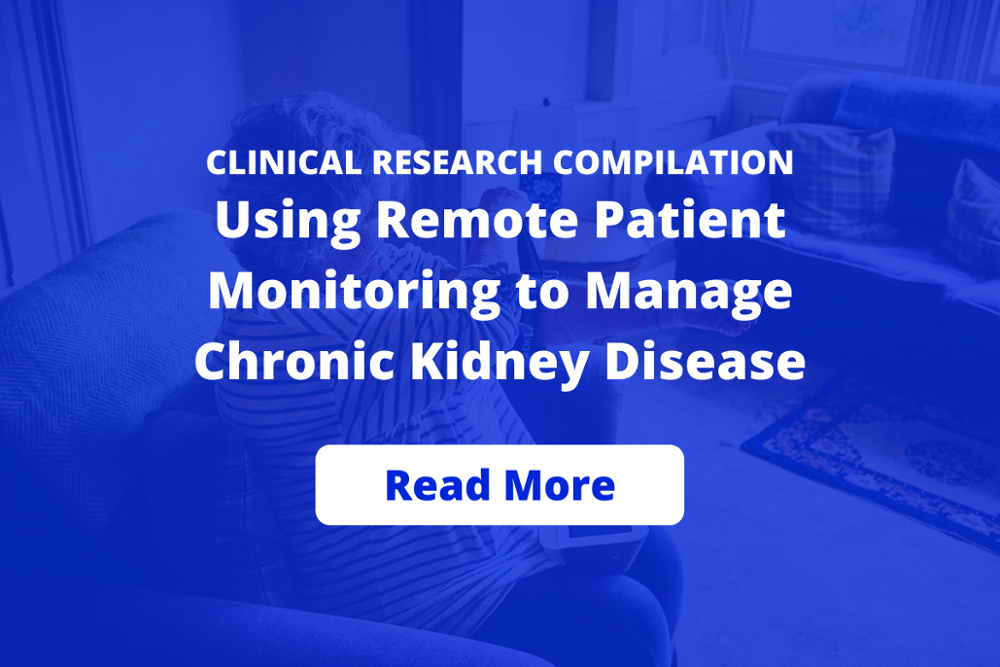November 1, 2022 •Optimize Health
More than 1 in 7 adults in the US have chronic kidney disease (CKD), but 90% of adults with CKD are undiagnosed. Given the lack of symptoms, it can be difficult to diagnose or slow CKD in the early stages. Once CKD progresses, the impact can be devastating. 350 people begin dialysis every day and less than half live past 5 years.
Research Supports the Role of RPM in Improving Blood Pressure, Increasing At-Home Dialysis Compliance, and Reducing Hospitalizations for Kidney Disease Patients
Clinical research shows that remote patient monitoring can improve outcomes for chronic kidney disease (CKD) patients. Connected blood pressure monitors provide more regular, accurate data to improve blood pressure control and detect potential organ failure is critical for CKD patients. Weight scales can be used to manage weight which can strain kidneys in overweight patients. Connected scales can also detect spikes in weight from fluid retention, a sign of decreased kidney function.
Another unique advantage of RPM for kidney patients is increasing the number of kidney patients that could be a good fit for peritoneal dialysis. Regular monitoring, treatment compliance, and ongoing education is critical for at-home dialysis patients and RPM is highly effective at exactly that.
We understand that healthcare providers need to direct their limited resources to programs that have been clinically proven to positively impact patient outcomes. That is why we compiled and synthesized a collection of 19 studies that scientifically demonstrate how RPM can help CKD patients.
Highlights of the Research on RPM for Kidney Disease Include
- At-home blood pressure monitoring outperforms in-office blood pressure monitoring for predicting kidney disease progression and improving blood pressure control. (source)
- At-home blood pressure monitoring is superior at detecting masked hypertension, white-coat hypertension, nondipping, and left-ventricular hypertrophy, making at-home monitoring a recommended treatment for managing hypertension for patients in all stages of CKD to predict organ damage. (source)
- Using RPM with peritoneal dialysis patients was associated with significant reductions in hospitalization rate (0.36 fewer hospitalizations per patient-year) and hospitalization days (6.57 fewer days per patient-year). (source)
- Interviews with RNs and nephrologists revealed concerns about catastrophic events and at-home safety of at-home dialysis. RPM reduces those concerns for clinicians. (source)
- Using RPM for peritoneal dialysis patients resulted in a significant reduction in: (source)
- Patient drop-out and technique failure
- Scheduled and unscheduled hospital visits
- Episodes of overhydration
- Rate of hospitalization
- Episodes of non-compliance to prescription
- Patient and hospital team time spent in traveling and management of therapy
- Healthcare costs and patient's expenditure
- Miles traveled by patients from home to hospital and vice versa
How to Use the RPM Chronic Kidney Disease Research
Physicians and ordering providers rely on the results of clinical research studies every day to make patient care decisions. If you have an existing RPM program or are considering launching one, these studies can be used to:
- Educate physicians on the clinical benefits of RPM
- Justify the investment of staff time and practice resources into launching or maintaining an RPM program
- Improve RPM patient identification and onboarding based on patient populations that can benefit from RPM
- Increase the number of dialysis patients eligible for at-home dialysis
Ready to Learn More
Clinical research has also demonstrated that RPM is effective for treating hypertension, heart failure, and diabetes. If you want to talk to an RPM expert about the clinical - and financial - benefits of RPM, please schedule a free consultation.
Share This: Back to Blog


